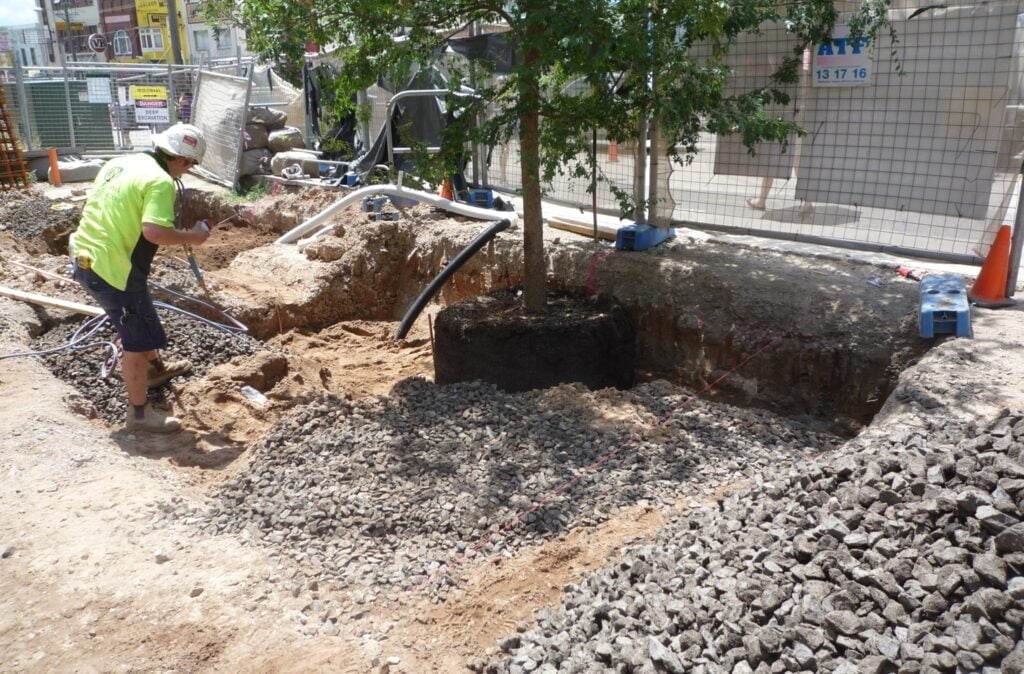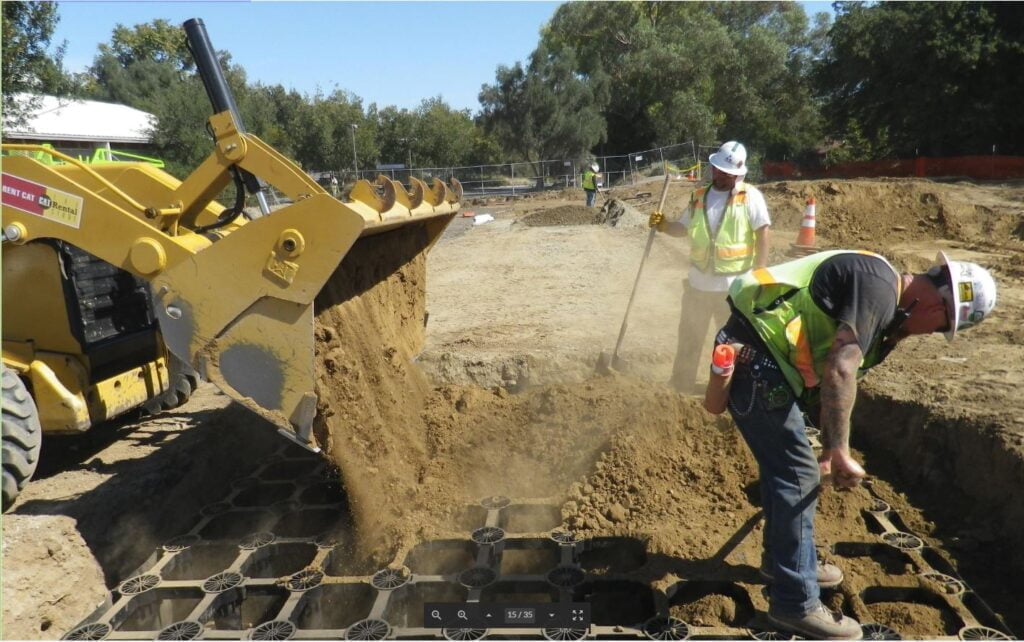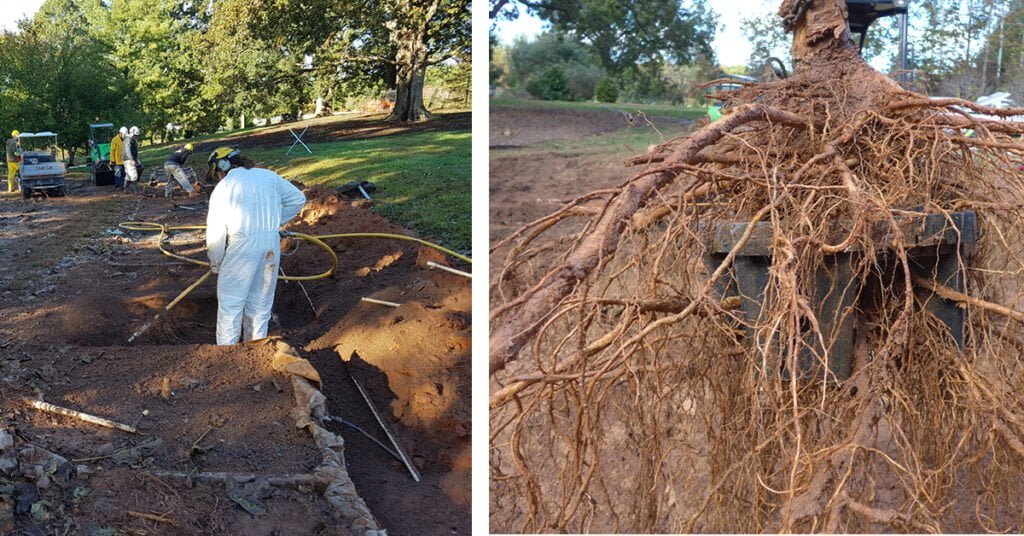Posted by Sophie Nichols on Wed, Jun 29, 2022 @ 1:06 AM
What is the Best Urban Tree Planting System?
When planting trees in urban areas, there are a few specific elements to consider. The first and most important thing to consider is that healthy trees require an adequate supply of loose, well-aerated, and uncompacted soil to thrive. This enables tree roots to obtain enough nutrients, oxygen and water so trees grow to their full potential in cityscapes.
In urban environments, where soil compaction is essential to provide safe support for sidewalks, roads, buildings, and pavements, a natural conflict arises when considering the planting of trees. This conflict arises because trees and their roots thrive in loose, uncompacted soil. Over the years, various methods have been employed to address this challenge and create suitable, uncompacted soil for urban trees. Among these methods, two primary practices have gradually emerged: structural growing media and supported pavement systems.
What is Structural Growing Media?
Structural Growing Media, otherwise known as Structural soil are soil mixes designed to be fully compacted to support vehicles whilst allowing tree root growth. An example of a structural growing media is the Cornell Mix, which combines rock and soil.
In developing and researching this specific mix, Grabosky and Bassuk (1996) found that there was about 30% void space in a mixture of 1.9 cm diameter crushed gravel, which could be filled with clay loam soil. Creating a stone matrix and suspending soil within the matrix pores meant that the larger diameter rocks would lock together and allow for full compaction, while soil would remain loose for root growth.
Is Structural Media Good for Trees?
While structural media can offer many benefits for urban trees, one drawback is that the actual volume of soil available for tree growth is typically less than what you’d find in a natural, uncompacted environment. This limitation can restrict the potential size and reach of a tree’s root system, impacting its overall health and stability. Urban trees face competition for space, which can limit their ability to access essential nutrients and water.
Therefore, in situations where ample space and natural soil conditions are available, traditional planting in natural soil may provide a more generous and unrestricted environment for tree growth. However, it’s essential to weigh these considerations against the benefits structural media offers, such as improved soil quality and the ability to plant trees in otherwise challenging urban spaces. Careful planning and maintenance can mitigate these limitations and ensure that trees thrive in urban environments.

What is Supported Pavement?
On the other hand, supported pavement systems involve engineering an underground solution for tree roots such as Stratavault so that pavement can be placed over uncompacted soil without impacting the soil quality and compaction of the soil below. Implementing a load-bearing bridge with low-density soil beneath ensures that the trees rooting space cannot become heavily compacted.
Why Use Supported Pavements for Trees?
Supported pavements are designed and used for the following reasons when it comes to trees:
- Root Protection: It serves as a protective layer for tree roots in urban areas. Tree roots can be sensitive to soil compaction and disturbance caused by heavy foot traffic or vehicular loads. Supported pavement provides a buffer zone that safeguards the roots from damage.
- Pedestrian Safety: Supported pavement ensures a level walking surface, reducing the risk of tripping and falling due to protruding tree roots. This promotes pedestrian safety, especially in areas with heavy foot traffic.
- Urban Infrastructure: In cityscapes, trees often coexist with various infrastructures such as sidewalks and roadways. Supported pavement helps manage tree roots, preventing them from disrupting or damaging these vital urban elements.
- Tree Health: By maintaining healthy soil conditions beneath the pavement in a separate contained environment such as those provided by soil cells, supported pavement allows trees to thrive in ideal growth conditions. Designed correctly it facilitates trees access to essential nutrients, water, and oxygen, promoting robust tree growth and longevity.
Studies have found that any system that allows trees to grow in non-compacted, low-density soil media will have the most excellent chance of achieving healthy tree growth (Rahman, 2013, Fite et al., 2014, Urban and Smiley, 2016).

Case Study: Comparison of Soil Treatments Under Concrete Pavement
One such study that Citygreen took part in was titled ‘Comparison of Soil Treatments Under Concrete Pavement’, conducted by the Tree Research Laboratory in Charlotte, North Carolina. The research compared tree root growth using supported pavement systems and structural growing media.
In the study, Citygreen’s Stratacell systems were tested. These structural soil vaults are modular units assembled below pavement level, which meet load-bearing requirements and provide a large volume of uncompacted soil for root growth.

The studies showed that the trees growing in these supported pavement treatments with low-density soil media had significantly more significant growth and generally appeared healthier.
So What is the Best Urban Tree Planting Method?
While the study did not point to a ‘best product’, it proved that structural load-bearing modules like Citygreen’s Stratacell and Stratavault systems provide the best results in urban areas, where compaction is a real issue. What this means for urban planners, landscape gardeners, architects, and developers are that by simply choosing a structural load-bearing soil system, they can achieve the canopy cover they require years sooner than they might with other systems. Essentially, cities, communities and individuals can enjoy the environmental, economic and health benefits of healthy canopies’ growth faster and for longer.
Have Someone from Citygreen contact You
For more information about our products and how we can help you create greener, more liveable cities, contact our friendly Citygreen Team now by clicking here.
Download the full report
To read more about how our system performed the best in terms of maximum root depth, moisture content and foliar colour, you can download the complete ‘Comparisons of Soil Treatments Under Concrete Pavement’ here.
References
Fite, K., E. Kramer, B. Scharenbroch, R. Uhlig, 2014. Beyond the Great Debate: Assessing Post Installation Manufactured Soils Performance. Presentation ASLA Annual Meeting, Denver, CO, USA. Grabosky, J. and N. Bassuk. 1996. Testing of Structural Urban Tree Soil Materials for Use, Under Pavement to Increase Street Tree Rooting Volumes. Journal of Arboriculture 22:255-263. Rahman, M. A. 2013. Effect of pit design and soil composition on the performance of Pyruscalleryana Street Trees in the Establishment Period. Arboriculture & Urban Forestry 39:256-266. Smiley, TE., Urban, J., and Kelby Fite, K. Comparison of Tree Responses to Different Soil Treatments Under Concrete Pavement. Arboriculture & Urban Forestry. Nov2019, Vol. 45 Issue 6, p303-314. 12p. Urban, J. and E.T. Smiley. 2014. Evaluation of Established Trees – Structural Soils and suspended pavement – Presentation at the International Society of Arboriculture Conference Milwaukee, WI, USA.

